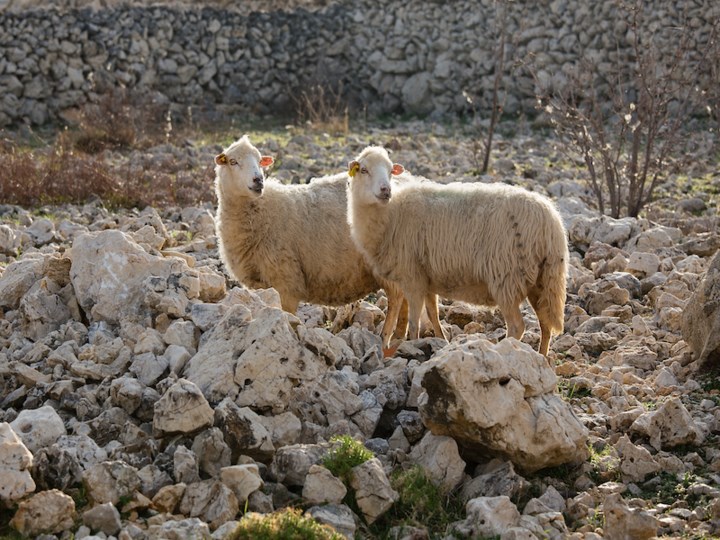In the northern part of the Adriatic Sea there is an
island recognisable for its rocky terrain, that resembles the surface of the moon.
Pag, the fifth largest island can boast of a delicacy for which it is recognisable to the wider region, but also to the world. Awards as well as numerous recognitions adorn this delicacy which can be found in many households. Let’s see what is lurking behind this golden treat.
Driving around the island of Pag, from Stara Novalja through Kolan, all the way to Lun, on every corner and along the road, you will notice
signs that say “Paski sir” or “Pag cheese”. The locals will gladly show you their products and sell you their homemade cheese.
The
municipality of Kolan is known for its cheesemaker factories that are mostly owned by local families, who pass on their knowledge and production from generation to generation. Most
local milkman store their milk before production in Kolan dairies (milk factories) before it is produced into hard quality cheese. What is interesting is that
they produce Pag cheese only by hand or as the locals of the island would say “na ruke” witch means “on hands”.

Cheese producers invest
a lot of effort and patience in the production of Pag cheese. In fact,
many factors affect the quality of cheese such as climate, soil type, natural vegetation, quality of pastures and plants, sheep and their milk. The microclimate of this island is very specific.
During the period when the cold
wind “bura” blows, in the direction from the mountain Velebit to the sea , it
carries a special spice of herbs that the locals call “posolica” or salt. The Pag cheese is made exclusively from the milk of a sheep called “Pramenka”. That is
why the cheese has a specific aroma that depends on the quality of the vegetation that these domestic animals eat and on which the quality of the cheese itself will later depend.
The cheese will be
better quality if it is made from the milk of sheep that grazed in June, since the vegetation is larger in this time of the year.
The herb sage (kadulja), which grows in this climate, also gives a special aroma to the cheese. Cheese made from this milk will have a more intense color and flavour. Pag cheese belongs in the category of expensive cheeses, precisely because of its quality and the time it takes to make it.

Sheep are milked twice a day, and one sheep produces about 0.75 litres of milk a day, and
for the production of 1 kg of Pag cheese, you will need 7 litres of sheep's milk, which tells us that hundreds of sheep's are needed to produce a larger amount of cheese. This is not a big problem for producers who own milking machines, but we need to take into consideration that most producers still milk their sheep by hand. This traditional way of production requires a lot of time and patience which makes Pag cheese so special. Since Pag cheese is
produced exclusively on the island of Pag, it is
protected because of the production skills and knowledge needed to make the cheese authentic.
The
cheese making process takes place in seven phases: heating, coagulation, grinding, reheating, pressing, salting and finally the most important which is the ripening of the cheese. The most interesting process is the ripening of the cheese. The island is also known for the salt production, so the producers use the salt form the island for the salting process.
After the salting, the cheeses are stacked on wooden shelves where they mature. The most important factor in this process is the wind “bura”. This particular wind benefits the development of mold on the rind of the cheese, which completes the production process of Pag cheese.

The
ripening process can take from 60 days to several years, on which the quality of the cheese will depend. The
longer the cheese matures, the harder and spicier it will be. The production of Pag cheese is not over yet, the cheeses need to be turned over and brushed every day, so the maturing takes a lot of patience. We must also point out the
cheeses from the "lug", or ash. It's a
method of packaging or canning cheeses in order to protect them from drying out and parasites that can harm the development of cheese. The cheese is rolled in ash, so that during the ripening the crust of the cheese becomes elastic and soft.
Pag cheese factories have been winning
numerous awards at world competitions for years. One of the world's most famous is the Gligora cheese factory located in Kolan, which cheese has already been awarded many times. Three international golden medals adorn this delicacy.
We are sure that the cheese lovers will enjoy this delicious treat. If you find yourself in one of our
villas in this region, be sure to visit the Pag cheese factories and see for yourself how much love, tradition and knowledge has been invested in the production of this popular Croatian delicacy.
Kristina Nikesic
26.01.2021

 MY ISTRIA GUIDE
MY ISTRIA GUIDE



